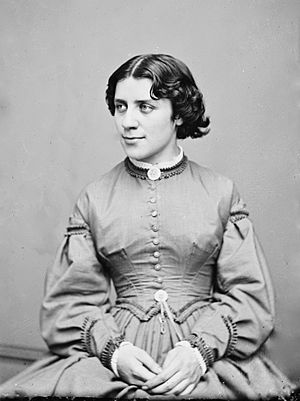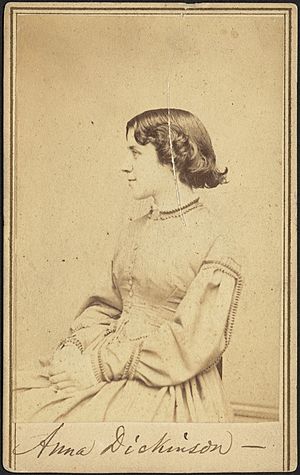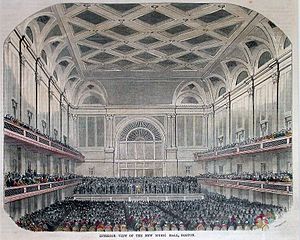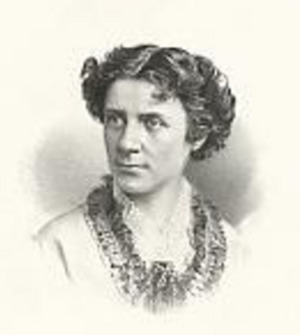Anna Elizabeth Dickinson facts for kids
Anna Elizabeth Dickinson (born October 28, 1842 – died October 22, 1932) was an amazing American speaker and writer. She was a strong supporter of ending slavery and gaining women's rights. Anna Dickinson made history as the first woman to give a political speech to the United States Congress.
She was a very talented speaker from a young age. She helped the Republican Party win important elections in 1863. This happened right before the Civil War and helped shape the country's political power. Anna Dickinson was also an adventurous mountaineer. She was the first white woman known to climb Colorado's Longs Peak, Lincoln Peak, and Elbert Peak (on a mule). She was also the second to climb Pike's Peak.
Contents
Anna Dickinson's Early Life
Anna Dickinson was born on October 28, 1842, in Philadelphia, Pennsylvania. Her parents, John and Mary Edmundson Dickinson, were Quakers and strongly against slavery. Her family had come to the United States from England in the 1660s. They settled with other Quakers near Easton, Maryland. Anna had three older brothers, John, Edwin, and Samuel, and an older sister, Susan.
Anna's father passed away in 1844 when she was only two years old. He died after giving a speech against slavery. Her family became very poor after his death. To support them, her mother, Mary, opened a school in their home. She also took in people who paid to live there. Anna went to school at Friends Select School in Philadelphia. She also attended Westtown School for a short time until she was 15. She was a very dedicated student. She spent any money she earned on books. Her mother had taught her to love classic literature. When she was 14, she joined the Methodist Church. She stayed active in the church throughout her life.
Anna Dickinson's Career as a Speaker
How Did Anna Dickinson Start Her Career?
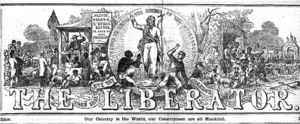
Anna Dickinson started working at age 15, around 1857, as a copyist. In 1859 and 1860, she worked as a teacher in Berks County, Pennsylvania. In May 1861, she got a job at the United States Mint. She was one of the first women to work there. However, she lost her job in December of that year. This happened because she publicly said that General George McClellan's poor performance in a battle was like treason.
Even before this, Anna had started speaking out. In 1856, when she was not yet 14, a newspaper called The Liberator published an essay she wrote. It was about how an anti-slavery teacher in Kentucky was treated badly.
Anna Dickinson: A Powerful Public Speaker
Anna Dickinson became widely known as a very clear and convincing public speaker. She was one of the first women to speak publicly about important issues of her time. Quakers, like her family, actually encouraged women to speak in public. She traveled around the country giving speeches for the Sanitary Commission, which helped soldiers during the war.
Friends like Lucretia Mott and Dr. Hannah Longshore encouraged her to speak. She gave passionate speeches about ending slavery, rebuilding the country after the war, women's rights, and the temperance movement (which aimed to reduce alcohol use). Her success paved the way for other women to become public speakers.
She first spoke publicly in 1857. She addressed a man who was making fun of women at a meeting. After that, she regularly spoke about temperance and ending slavery. In 1860, she spoke in Philadelphia about The Rights and Wrongs of Women. She then spoke to the Pennsylvania Anti-Slavery Society later that year.
Her first big speech, a two-hour talk about The Rights and Wrongs of Women, was on February 27, 1861. Lucretia Mott, a famous Quaker speaker, helped sell 800 tickets for the event. Mott also arranged for the 19-year-old Anna to go on a lecture tour. This tour was sponsored by the Massachusetts Anti-Slavery Society. Anna quickly became a very popular speaker. Her speeches helped the movement to end slavery.
After hearing her speak, William Lloyd Garrison, the owner of The Liberator, arranged for her to speak at the Boston Music Hall in 1862. He called her "The Girl Orator." She spoke about "The National Crisis," referring to the Civil War. During the war, she visited hospitals and army camps to speak to soldiers. In 1862, she visited wounded soldiers. She then gave a lecture about "Hospital Life" in New England.
During the 1863 elections, as the Civil War continued, Anna Dickinson campaigned for pro-Union Republican candidates. She spoke in New York, Pennsylvania, New Hampshire, and Connecticut. Her audiences included people who did not support the war. She spoke powerfully in favor of the Radical Republican's anti-slavery ideas and for keeping the Union together. She even spoke to coal miners in Pennsylvania after some riots there. She convinced many men who had not supported ending slavery before. Anna Dickinson was called the "Civil War's Joan of Arc" because of her strong support for the Union. She strongly criticized those who opposed the war. In 1863, she was interviewed by Whitelaw Reid, who often wrote about her speeches in the New York Tribune newspaper.
When she spoke at Cooper Institute in New York City, more than 5,000 people came to listen. People said she could "hold her audience spellbound for as much as two hours." In 1864, she received a standing ovation for a powerful speech. This speech was given on the floor of the United States House of Representatives. President Abraham Lincoln and other important leaders were there. Republican leaders invited her, making her the first woman to speak to Congress.
After the Civil War, Anna remained one of the country's most famous speakers for almost ten years. She earned a lot of money, sometimes as much as $20,000 a year. She gave a speech almost every other day. She gave most of her earnings to charity, friends, and family. She also kept a nice house in Philadelphia for her mother and sister.
She spoke about rebuilding the country, rights for African Americans, and women's rights in her speech Between Us Be Truth. She also spoke about polygamy in Utah in her speech "Whited Sepulchers." Even though she called for women's rights, she was not a main speaker for the suffrage movement (the movement for women to vote). Some of her popular post-war speeches included For Yourself and Platform and Stage. She often spoke about Joan of Arc.
Over time, audiences preferred entertainment over serious lectures. Also, her career as a lecturer declined after she supported a different presidential candidate in 1872. By 1875, she could not support herself just by speaking. She gave speeches for Republicans in the 1888 United States presidential election. However, her performance was not well-received. Newspapers began to question her mental state. The Republicans stopped booking her for speeches. She was never hired by the party again.
Anna Dickinson's Mountaineering Adventures
As her speaking career slowed down, Anna was invited to Colorado in 1873. Over three weeks, she climbed several mountains. These included Pikes Peak, Mount Lincoln, Grays Peak, and Mount Elbert. She often used horses or mules to help her. She also joined a survey team for a climb of Longs Peak. Anna hoped this publicity would help her career. A local newspaper even reported the scandalous detail that she wore trousers for the climb!
Anna Dickinson was the first white woman known to reach the top of Colorado's Gray's Peak, Lincoln Peak, and Elbert Peak (on a mule). She was the second to climb Pike's Peak. She was also the third white woman known to climb Colorado’s Longs Peak in 1873. She was definitely the first well-known woman to do so.
Anna Dickinson as an Author and Actress
To earn money, Anna also started writing. She published a novel called What Answer? in 1868. This book discussed negative views about interracial marriage. It is considered her most daring work. In her book A Paying Investment, a Plea for Education (1876), she argued for job training for workers. She also called for better treatment of prisoners, help for the poor, and required education for all children. Anna Dickinson wrote A Ragged Register of People, Places and Opinions in 1879.
She also wrote plays. In The Crown of Thorns (1876), she played the role of Anne Boleyn. However, the play and her acting were not well-received in New York. She also appeared in the main role of Mary Tudor (1878). Her other plays included Aurelian (1878) and An American Girl (1880). The play An American Girl was successfully performed by Fanny Davenport. Anna even performed as Hamlet on Broadway. However, she did not have much success as an actress.
Anna Dickinson's Personal Life
Anna Dickinson was friends with important women like Elizabeth Cady Stanton and Quaker speakers Lucretia Mott and Susan B. Anthony. In her letters, Susan B. Anthony sometimes called Anna "Chickie Dickie." Benjamin F. Butler, a Civil War general and politician, was interested in her romantically. He remained her friend, gave her legal advice, and helped her with money for many years.
In 1870, Anna was the main earner and head of her household. She lived with her mother, older sister Susan, and a servant. In 1883, she moved to West Pittston, Pennsylvania to live with her sister. Over the next few years, her health began to decline as she got older. This was also due to many years of not having much money. On May 12, 1889, her 95-year-old mother, Mary, passed away in West Pittston. Mary had been ill for years and was cared for by her daughters, Susan and Anna.
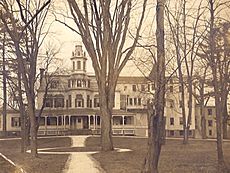
In 1891, Anna started showing signs of paranoia. Her sister Susan Dickinson had her sent to a hospital for the mentally ill, the Danville State Hospital for the Insane. She was later moved to a private hospital in Goshen, New York. This was done with the help of her friends and under the care of Dr. Seward. This move happened partly because newspapers were reporting false information about her care. Anna was taken to Danville in February 1891. She stayed at the Interpines sanitarium and was giving lectures again by late August that same year.
She filed lawsuits against the newspapers that claimed she was insane. She also sued the people who had her committed. After long legal battles, she won the case of illegal kidnapping and three libel lawsuits in 1898. However, she lost many supporters and friends because of her difficult behavior.
After she was released from Danville, she lived in Goshen, New York with George and Sallie Ackley. She continued to live with them for over forty years. When Sallie passed away, she left $7,000 to Anna. The understanding was that any money left when Anna died would go to George. Anna Dickinson passed away in 1932 from a stroke. Since she did not leave a will, the remaining $6,000 went to a distant cousin, not to George. Anna Dickinson is buried at Slate Hill Cemetery in Goshen, near George and Sallie's gravestone.
Legacy and Honors
- The World War II Liberty Ship SS Anna Dickinson was named in her honor.


